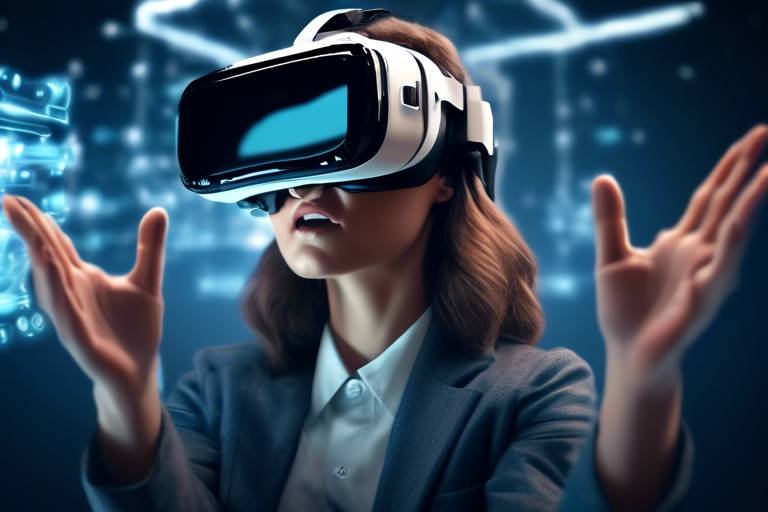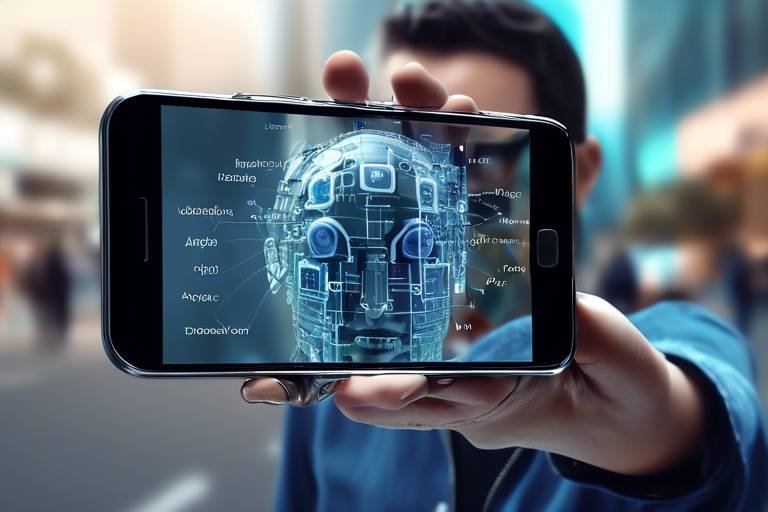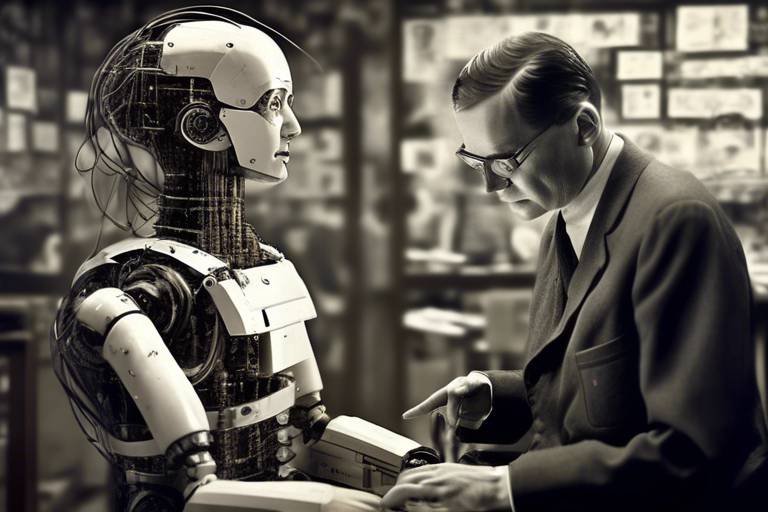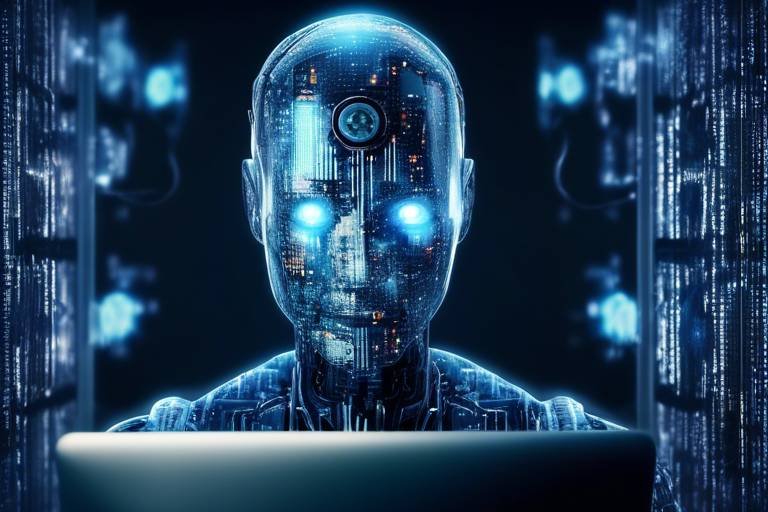Empowering Virtual Reality with AI
In recent years, the worlds of Artificial Intelligence (AI) and Virtual Reality (VR) have begun to intertwine in ways that many of us couldn't have imagined just a decade ago. The fusion of these technologies is not merely a trend; it's a revolution that is reshaping how we interact with digital environments. Imagine stepping into a world where the virtual landscape adapts to your emotions, preferences, and even your actions. This is not science fiction; it’s the future that AI is crafting for VR. As we delve deeper into this topic, we will explore how AI is enhancing user experiences, creating immersive environments, and paving the way for unprecedented applications across various industries.
At its core, the integration of AI into VR is about making experiences more engaging and personalized. Think about your favorite video game or educational simulation. Now, imagine if that experience could learn from you, adapting its storyline, challenges, and interactions based on your unique playstyle or learning pace. This is the magic of AI in VR; it's not just about creating a virtual world but about crafting a world that feels alive and responsive to you. As we explore the intersection of these technologies, we will uncover the remarkable advancements that are transforming user experiences and the possibilities that lie ahead.
Moreover, the implications of this synergy extend far beyond entertainment. Industries such as healthcare, education, and even social networking are beginning to harness the power of AI-enhanced VR to create solutions that were previously thought impossible. For instance, imagine a medical student practicing surgery in a hyper-realistic environment where AI not only simulates the surgical procedures but also provides real-time feedback based on the student’s performance. The potential applications are vast and exciting, and as we progress through this article, we will highlight some of the most groundbreaking examples of AI-powered VR in action.
- What is the main benefit of combining AI with VR?
Combining AI with VR enhances user experiences by providing personalized, adaptive environments that respond to individual preferences and behaviors. - How is AI used in healthcare VR applications?
AI is used to create realistic simulations for training medical professionals, allowing them to practice skills in a safe and controlled environment. - Can AI improve educational experiences in VR?
Yes, AI can tailor educational content to suit different learning styles, making complex subjects more accessible and engaging for students.

The Intersection of AI and VR
This article explores the transformative impact of artificial intelligence on virtual reality, highlighting advancements, applications, and future possibilities that enhance user experiences and create immersive environments.
The fusion of Artificial Intelligence (AI) and Virtual Reality (VR) is nothing short of revolutionary. Imagine stepping into a world where your every move is anticipated, and the environment adapts to your preferences in real-time. This is the magic that happens when AI technologies integrate with VR systems. By enhancing realism, interactivity, and personalization, this intersection creates experiences that are not only engaging but also deeply immersive. From gaming to education, the applications are vast and varied.
At the core of this integration lies the ability of AI to analyze vast amounts of data. For instance, in a gaming environment, AI can monitor how players interact with the game, identifying patterns and preferences. This data is then used to adjust the game dynamically, ensuring that each player has a unique experience tailored to their specific interests. Imagine a game that evolves based on your choices, creating a storyline that feels personal and engaging—this is the future of gaming powered by AI and VR.
Moreover, the educational sector is experiencing a similar transformation. Students can engage with complex subjects through interactive VR simulations that adapt to their learning styles. AI algorithms can assess a student's progress and modify the learning experience accordingly, ensuring that no one is left behind. This personalized approach not only enhances understanding but also fosters a deeper connection with the material being studied.
In terms of realism, AI plays a crucial role in creating lifelike environments. By utilizing machine learning, AI can generate realistic graphics and physics, making virtual worlds more believable. This level of detail allows users to immerse themselves fully, whether they are exploring a virtual museum or conducting a surgical procedure in a simulated environment.
Furthermore, the potential for social interaction within these virtual spaces cannot be overlooked. AI can facilitate meaningful connections among users, enabling them to communicate and collaborate in ways that transcend geographical boundaries. Imagine attending a virtual conference where AI helps match you with like-minded individuals based on your interests and professional background. The possibilities are endless, and the future looks bright.
In summary, the intersection of AI and VR is not just a technological trend; it represents a significant shift in how we interact with digital content. As these technologies continue to evolve, we can expect even more sophisticated applications that enhance user experiences and redefine what is possible in virtual environments.
- What is the main benefit of combining AI with VR?
The main benefit is the ability to create personalized, adaptive experiences that enhance user engagement and immersion. - How does AI improve VR gaming?
AI analyzes player behavior to dynamically adjust the game, creating unique storylines and challenges tailored to individual players. - Can AI help in educational settings?
Yes, AI can create interactive learning experiences that adapt to students' needs, improving understanding and retention of complex subjects. - What future advancements can we expect?
We can anticipate improvements in hardware, graphics, and social interactions within virtual spaces, making them more immersive and accessible.

Enhanced User Experiences
In the ever-evolving world of technology, artificial intelligence (AI) is revolutionizing the landscape of virtual reality (VR) by enhancing user experiences in ways we could only dream of a few years ago. Imagine stepping into a virtual world where everything feels tailored just for you—sounds incredible, right? That's the magic of AI! By harnessing the power of AI-driven algorithms, VR applications can analyze your behavior and preferences in real-time, adapting the experience to cater to your individual needs. This level of customization not only boosts enjoyment but also significantly improves overall satisfaction.
One of the most exciting aspects of this enhancement is the ability of AI to deliver personalized experiences. Think about your favorite video game or educational simulation; wouldn't it be amazing if the storyline or challenges adjusted based on your choices? With AI, this is not just a possibility; it's becoming a reality. AI employs various methods to customize VR environments, ensuring that every user feels like the main character in their own story. From adaptive storytelling to dynamic content generation, the possibilities are virtually limitless.
Let’s delve deeper into some of the personalization techniques that AI utilizes to create immersive VR experiences. One key method is adaptive storytelling. This technique allows narratives to shift and evolve based on user interactions, making each journey unique. Imagine exploring a lush fantasy world where the characters react differently depending on your choices, creating a truly engaging adventure.
Another fascinating aspect is dynamic content generation. AI can generate unique scenarios and environments on the fly, ensuring that no two experiences are ever the same. For instance, if you're in a VR training simulation for a medical procedure, the AI can create various patient scenarios that challenge your skills in different ways, keeping you on your toes and enhancing your learning experience.
Moreover, AI enhances user-specific interactions. By leveraging machine learning, AI systems can learn about your preferences, making interactions more intuitive. For example, if you're using a VR platform for education, the AI might recognize that you struggle with certain concepts and adjust the difficulty level or offer additional resources tailored to your learning style. This kind of personalization fosters a deeper connection between you and the virtual world, making the experience not just enjoyable but also educational.
AI's ability to analyze user behavior in VR environments is another game-changer. By observing how you interact within the virtual space, AI can gather valuable insights that refine experiences and improve design. For instance, if the system notices that users often get stuck at a particular point in a game or simulation, it can prompt developers to modify that section for better flow. This continuous feedback loop ensures that VR applications are constantly evolving to meet the changing needs of users, making them more engaging and effective.
In conclusion, the integration of AI into virtual reality is not just about creating stunning graphics or realistic environments; it's about crafting personalized experiences that resonate with users on a deeper level. As we continue to explore the potential of AI in VR, we can expect even more innovative solutions that enhance user engagement and satisfaction.
- How does AI improve VR experiences?
AI enhances VR by personalizing experiences based on user behavior, allowing for adaptive storytelling and dynamic content generation. - Can AI create unique narratives in VR?
Yes, AI can generate unique narratives that evolve based on user choices, providing a customized experience for each individual. - What industries benefit from AI-enhanced VR?
Industries such as healthcare, education, and entertainment are seeing significant benefits from AI-enhanced VR applications. - Will AI make VR experiences more immersive?
Absolutely! AI helps create more engaging and immersive environments by tailoring interactions and content to individual users.

Personalization Techniques
When it comes to creating a truly immersive experience in virtual reality (VR), personalization is the name of the game. Imagine stepping into a virtual world that feels tailor-made just for you! AI plays a crucial role in this process, using advanced algorithms to analyze user preferences and behaviors. This allows VR environments to adapt dynamically, ensuring that each user's experience is unique and engaging. But how does this magic happen? Let's dive into some of the fascinating techniques AI employs to customize VR experiences.
One of the standout methods is adaptive storytelling. This technique allows the narrative to evolve based on the user's choices and actions. Picture this: you're in a VR adventure where every decision you make influences the storyline. If you choose to save a character, the plot might take a heroic turn, while a different choice could lead to unexpected challenges. This level of interactivity not only keeps users on their toes but also fosters a deeper emotional connection to the story.
Another exciting aspect of personalization is dynamic content generation. AI can create unique scenarios and environments that respond to the user's interactions. For example, in a VR training simulation, the AI can generate realistic challenges that reflect the user's skill level, ensuring that the experience is neither too easy nor overwhelmingly difficult. This adaptability enhances learning and engagement, making each session feel fresh and relevant.
Moreover, user-specific interactions are a game-changer. By leveraging machine learning, AI systems can learn from user behavior over time. This means that the more you interact with the VR environment, the better it understands your preferences. It can suggest new experiences, adjust difficulty levels, and even modify visual or auditory elements to suit your tastes. Imagine a VR game that recognizes your favorite play style and adjusts the gameplay accordingly—how cool is that?
To illustrate these techniques further, consider the following table that summarizes how AI enhances personalization in VR:
| Technique | Description | Benefits |
|---|---|---|
| Adaptive Storytelling | Dynamic narratives that change based on user choices. | Increased engagement and emotional connection. |
| Dynamic Content Generation | AI creates unique scenarios tailored to user skills. | Enhanced learning and relevance of experiences. |
| User-Specific Interactions | AI learns from user behavior to customize experiences. | Improved satisfaction and personalized gameplay. |
In summary, the techniques used by AI to personalize VR experiences are not just innovative; they are revolutionary. By making environments responsive to individual users, AI ensures that every interaction is meaningful and engaging. So, the next time you don your VR headset, remember that the experience you’re having is uniquely yours, crafted by the powerful combination of AI and immersive technology.
- How does AI personalize VR experiences? AI analyzes user behavior and preferences to adapt the VR environment in real-time, creating a tailored experience.
- What are some examples of personalization in VR? Examples include adaptive storytelling, dynamic content generation, and user-specific interactions that enhance engagement.
- Can AI improve learning outcomes in VR? Yes, AI can create customized training scenarios that adjust to the user's skill level, promoting better learning and retention.
- Is personalization in VR limited to gaming? No, personalization techniques are also applied in education, healthcare, and other industries to enhance user experiences.

Dynamic Content Generation
Imagine stepping into a virtual world where the story unfolds uniquely for you, based on your choices and actions. This is the magic of in virtual reality (VR), powered by artificial intelligence (AI). Unlike traditional VR experiences that follow a linear narrative, dynamic content generation creates a tailored journey for each user, making every interaction feel fresh and engaging. Through the use of advanced algorithms, AI analyzes user inputs in real-time, allowing the virtual environment to adapt and evolve as the user navigates through it.
One of the key components of dynamic content generation is the ability to create personalized narratives. For instance, in a VR adventure game, if a player decides to ally with a specific character, the storyline can shift dramatically, leading to different quests, challenges, and endings. This not only enhances the immersive experience but also encourages players to explore various paths, fostering a sense of agency and ownership over their journey. The possibilities are endless, as AI can generate unique scenarios based on a myriad of factors, including user behavior, preferences, and even emotional responses.
Additionally, the technology behind dynamic content generation can be applied across various fields. In educational VR applications, students can engage with interactive lessons that adapt to their learning pace and style. For example, if a student struggles with a particular concept, the AI can introduce additional resources or alternative explanations that cater to their understanding. This level of customization not only enhances learning outcomes but also keeps students motivated and involved.
Moreover, dynamic content generation can facilitate real-time feedback within VR environments. Users can receive instant responses to their actions, creating a more interactive atmosphere. Picture this: you’re in a virtual art gallery, and as you approach a painting, the AI generates a unique backstory or artistic critique based on your previous interests and interactions. This not only enriches the experience but also deepens the user's connection to the content.
In summary, dynamic content generation is revolutionizing how we interact with virtual environments. By leveraging AI, VR can offer experiences that are not only immersive but also deeply personalized. This technology is paving the way for a future where virtual interactions are as rich and varied as real-life experiences, transforming the way we learn, play, and engage with digital worlds.
- What is dynamic content generation in VR? Dynamic content generation refers to the ability of AI to create personalized narratives and experiences in virtual reality based on user interactions and choices.
- How does AI enhance the VR experience? AI enhances VR by analyzing user behavior in real-time, allowing for tailored experiences that adapt to individual preferences and actions.
- Can dynamic content generation be used in education? Yes, it can create interactive learning experiences that adjust to a student's learning pace and style, promoting deeper understanding.
- What are the benefits of personalized narratives in VR? Personalized narratives increase user engagement, provide a sense of agency, and encourage exploration within the virtual environment.

User-Specific Interactions
In the realm of virtual reality (VR), the magic truly happens when come into play. Imagine stepping into a virtual world where every element responds to your unique preferences and behaviors. This is not just a fantasy; it is the reality that artificial intelligence (AI) is creating within VR environments. By leveraging advanced machine learning algorithms, AI systems can analyze and understand individual user patterns, making interactions feel more intuitive and personal.
For instance, consider a VR game where your choices shape the storyline. AI can track your decisions, predicting what you might want to do next based on your previous actions. This level of personalization transforms the gaming experience from a linear narrative into a dynamic adventure that feels tailor-made just for you. It’s like having a personal storyteller who knows exactly what you enjoy and adapts the tale accordingly.
Moreover, these user-specific interactions extend beyond gaming. In educational VR applications, students can engage with content that resonates with their learning styles. For example, a visual learner might benefit from immersive graphics and simulations, while an auditory learner could receive verbal instructions and feedback. This adaptability not only enhances engagement but also fosters a deeper understanding of complex subjects.
To illustrate how AI personalizes user interactions in VR, consider the following table that outlines different interaction types:
| Interaction Type | Description | Example |
|---|---|---|
| Adaptive Responses | AI adjusts the environment based on user behavior. | Changing difficulty levels in a game based on player performance. |
| Personalized Feedback | Real-time feedback tailored to the user's actions. | Providing hints based on user struggles in a puzzle. |
| Custom Content Delivery | Delivering content that aligns with user interests. | Suggesting relevant educational materials based on past interactions. |
In addition to improving engagement, user-specific interactions also foster a greater sense of connection between the user and the virtual environment. When users feel that their actions and preferences are acknowledged, they are more likely to immerse themselves fully in the experience. This emotional connection can lead to increased satisfaction and a desire to explore further.
Ultimately, the future of user-specific interactions in VR is bright. As AI technology continues to evolve, we can expect even more sophisticated systems that learn and adapt in real-time, creating experiences that are not only personalized but also deeply engaging. This shift will redefine how we interact with virtual worlds, making them feel less like simulations and more like extensions of our own reality.

Behavior Analysis
In the realm of virtual reality (VR), understanding user behavior is akin to holding a treasure map that leads to richer experiences. AI's capability to analyze user behavior within VR environments is not just a technical marvel; it's a game-changer that opens up a world of possibilities. By leveraging advanced algorithms, AI can sift through vast amounts of data, identifying patterns and preferences that would otherwise go unnoticed. Imagine a virtual world that learns from you, adapting and evolving to create an experience that feels uniquely yours. This is the power of behavior analysis in VR.
Through continuous monitoring, AI systems can gather insights on how users interact with their virtual surroundings. This includes tracking movements, engagement levels, and even emotional responses. For instance, if a user spends more time in a particular area of a VR environment, the system can infer that this space is engaging and may choose to enhance it further. Conversely, if users quickly exit a scene, it can signal that adjustments are needed to improve that experience. In essence, AI acts as a silent observer, learning and refining the environment to cater to the user's desires.
Moreover, the insights gained from behavior analysis can significantly influence the design and development of future VR applications. Developers can create tailored content that resonates with users on a personal level, enhancing their overall satisfaction. For example, if data reveals that users enjoy collaborative tasks, developers can introduce more multiplayer features or cooperative challenges. The result? A more engaging and fulfilling experience that keeps users coming back for more.
To illustrate the impact of behavior analysis in VR, consider the following table that highlights key benefits:
| Benefit | Description |
|---|---|
| Enhanced Personalization | AI can tailor experiences based on individual user preferences and behaviors. |
| Improved Design | Insights from user interactions help refine VR environments for better engagement. |
| Increased User Satisfaction | By addressing user needs, the overall satisfaction and retention rates improve. |
| Adaptive Learning | AI can create learning paths that evolve with the user's progress and interests. |
Ultimately, the fusion of AI and behavior analysis in VR is not just about creating a more enjoyable experience; it's about forging a deeper connection between users and the virtual worlds they inhabit. As technology continues to advance, we can expect even more sophisticated behavior tracking methods that will further enhance the realism and interactivity of VR. This means that the future holds exciting prospects for personalized experiences that resonate with users, making them feel like active participants in their own stories.
- What is behavior analysis in virtual reality? Behavior analysis in VR involves examining user interactions to tailor experiences and improve engagement.
- How does AI enhance user experiences in VR? AI analyzes user behavior to create personalized content and adaptive environments that respond to individual preferences.
- Can behavior analysis improve VR applications? Yes, insights gained from behavior analysis can lead to better design and more engaging content in VR applications.
- What industries benefit from AI-driven behavior analysis in VR? Various sectors including healthcare, education, and entertainment leverage AI to enhance training, learning, and user engagement.

Applications in Various Industries
The integration of AI-enhanced virtual reality (VR) is not just a futuristic concept; it’s already making waves across various industries. Imagine stepping into a virtual world where the boundaries of reality blur, and your experiences are tailored just for you. This is not a scene from a sci-fi movie, but rather the new reality in fields like healthcare, education, and entertainment. Each sector is leveraging the unique capabilities of AI and VR to revolutionize traditional practices, making them more efficient, engaging, and effective.
In healthcare, the marriage of AI and VR is particularly powerful. Medical professionals can now train in immersive environments that simulate real-life scenarios. This advanced training method not only enhances their skills but also prepares them for high-pressure situations they may encounter in the field. For example, AI-driven VR can create lifelike patient interactions, allowing doctors to practice their responses in a safe environment. This hands-on experience is invaluable, as it cultivates confidence and competence in a way that traditional training methods simply cannot.
Similarly, the education sector is experiencing a transformation thanks to the synergy of AI and VR. Students are no longer confined to textbooks and lectures; instead, they can immerse themselves in interactive simulations that bring complex subjects to life. Picture a history lesson where students can virtually walk through ancient civilizations or a biology class that allows them to explore the human body from the inside out. These experiences not only enhance understanding but also promote retention of knowledge, as learners engage with material in a dynamic and memorable way.
Furthermore, the entertainment industry is also embracing AI-enhanced VR to create more engaging and interactive experiences. Video games, for instance, are evolving into immersive worlds where players can influence the storyline through their choices. AI algorithms analyze player behavior, adjusting the game’s challenges and narratives in real-time to maintain engagement and excitement. This level of interactivity is changing how we perceive entertainment, making it more personal and thrilling.
To illustrate the impact of AI-enhanced VR across these industries, let’s look at a table summarizing some key applications:
| Industry | Application | Benefits |
|---|---|---|
| Healthcare | Medical Training Simulations | Improves skills, prepares for real-life scenarios |
| Education | Interactive Learning Experiences | Enhances understanding and retention |
| Entertainment | Immersive Gaming | Personalized narratives and challenges |
As we can see, the applications of AI-enhanced VR are vast and varied, each offering unique benefits that improve learning, training, and entertainment experiences. The potential for this technology is just beginning to be realized, and as it continues to evolve, we can expect even more innovative uses across different fields.
- What is AI-enhanced VR? AI-enhanced VR refers to the integration of artificial intelligence technologies within virtual reality systems, allowing for more realistic, interactive, and personalized experiences.
- How is AI used in healthcare training? AI is used to create realistic simulations of medical scenarios, enabling healthcare professionals to practice their skills in a safe, controlled environment.
- Can AI and VR improve educational outcomes? Yes! By creating immersive learning experiences, AI and VR can help students engage more deeply with the material, enhancing their understanding and retention.
- What are some future trends in AI-enhanced VR? Future trends may include advancements in hardware for better graphics and reduced latency, as well as more sophisticated applications for social interaction in virtual environments.

Healthcare Innovations
The integration of artificial intelligence (AI) with virtual reality (VR) is creating groundbreaking innovations in the healthcare sector that are transforming how medical professionals are trained and how patients receive care. Imagine a world where medical students can practice complex surgeries in a risk-free virtual environment, honing their skills before ever stepping into an operating room. This is not just a dream; it’s a reality made possible by AI-enhanced VR technologies. These immersive simulations allow healthcare practitioners to experience realistic scenarios that mimic real-life challenges and pressures, thereby enhancing their decision-making skills and clinical competencies.
One of the most exciting aspects of AI in healthcare VR is its ability to provide personalized training experiences. Through advanced algorithms, these systems can adapt to the learning pace and style of each individual. For instance, a surgical trainee can engage in a simulation that adjusts its difficulty based on their performance, ensuring they are always challenged but never overwhelmed. This tailored approach not only boosts confidence but also significantly improves retention of knowledge and skills. The result? A new generation of healthcare professionals who are better prepared for the demands of their jobs.
Moreover, AI-driven VR is not limited to training; it extends to patient therapy as well. For example, VR is being used in pain management, where patients can immerse themselves in calming environments that distract from pain sensations. AI algorithms analyze patient feedback in real-time, adjusting the virtual experience to maximize comfort and effectiveness. This innovative approach has been shown to reduce the need for medication, providing a holistic alternative for pain relief.
In addition to training and therapy, AI-enhanced VR is making waves in patient rehabilitation. For instance, stroke patients can engage in VR exercises that are tailored to their recovery needs, allowing them to practice movements in a safe and controlled environment. The AI component continuously monitors their progress, adapting the difficulty of exercises to ensure optimal recovery while keeping patients motivated. This element of gamification not only makes rehabilitation more engaging but also leads to better outcomes.
As we look to the future, the potential for AI and VR in healthcare is immense. With ongoing advancements in technology, we can expect even more sophisticated applications that will further enhance training, patient care, and rehabilitation. The synergy between AI and VR is not just reshaping healthcare; it's revolutionizing it, paving the way for a future where medical professionals are better equipped, and patients receive more compassionate and effective care.
- What is AI-enhanced VR in healthcare?
AI-enhanced VR in healthcare refers to the integration of artificial intelligence with virtual reality technologies to improve medical training, patient therapy, and rehabilitation processes. - How does AI personalize training for medical professionals?
AI personalizes training by adapting simulations to the individual’s learning pace and style, ensuring that each trainee is challenged appropriately. - Can VR help with pain management?
Yes, VR can help with pain management by immersing patients in calming environments, which can distract them from pain sensations and reduce the need for medication. - What are the benefits of using VR for patient rehabilitation?
VR for rehabilitation allows patients to practice movements in a safe environment, with AI monitoring their progress and adjusting exercises to ensure optimal recovery.

Educational Advancements
The fusion of artificial intelligence (AI) and virtual reality (VR) has opened up a world of possibilities in the realm of education. Imagine walking into a virtual classroom where the environment adapts to your learning style, where complex subjects are transformed into interactive experiences that engage your senses and spark your curiosity. This is not just a dream; it’s becoming a reality as AI enhances VR learning environments.
AI algorithms analyze individual student behaviors, preferences, and learning speeds, allowing educational platforms to create a truly personalized learning experience. For instance, if a student struggles with a particular math concept, the AI can adjust the VR content to provide additional resources, such as interactive simulations or tailored quizzes, ensuring that the student grasps the material before moving on. This level of customization not only boosts understanding but also fosters a sense of achievement and confidence.
Moreover, VR can simulate real-life scenarios that are often hard to replicate in traditional classrooms. For example, medical students can practice surgeries in a risk-free virtual environment, gaining hands-on experience without the fear of making mistakes. Similarly, history students can “visit” ancient civilizations, exploring their architecture and culture firsthand, which makes the learning process much more engaging. The immersive nature of VR, combined with AI's adaptability, allows for a richer educational experience that can lead to better retention of information.
Here are some key advancements in educational technologies powered by AI and VR:
- Interactive Simulations: Students can engage in real-world scenarios, such as conducting scientific experiments or managing a business, all within a controlled virtual space.
- Gamified Learning: AI can create game-like environments that make learning fun and competitive, encouraging students to participate actively.
- Collaborative Learning: VR can facilitate group projects where students from different locations can come together in a virtual space to collaborate on assignments, enhancing teamwork skills.
As we look to the future, the potential for AI and VR in education is immense. With advancements in technology, we can expect even more sophisticated tools that make learning not just effective but also enjoyable. Imagine a classroom where every student is engaged, where learning feels less like a chore and more like an adventure. The possibilities are endless, and the journey has only just begun.
1. How does AI enhance virtual reality in education?
AI analyzes student behavior and preferences, allowing for personalized learning experiences that adapt in real-time to meet individual needs.
2. What are some examples of VR applications in education?
VR is used for interactive simulations, gamified learning environments, and collaborative projects that allow students to engage with the material in innovative ways.
3. Can VR help with subjects that are typically difficult to learn?
Absolutely! VR can simplify complex subjects by providing immersive experiences that make learning more intuitive and engaging.
4. What is the future of AI and VR in education?
The future looks promising, with advancements expected to create even more immersive, interactive, and personalized learning experiences.

Future Trends and Possibilities
The future of artificial intelligence (AI) and virtual reality (VR) holds immense potential, promising to reshape our interactions with digital environments in ways we can only begin to imagine. As technology continues to evolve, the synergy between AI and VR is expected to deepen, leading to innovations that will redefine how we experience virtual worlds. Imagine stepping into a fully immersive environment that not only reacts to your movements but also anticipates your needs and preferences. This is not just a dream; it’s on the horizon!
One of the most exciting trends is the advancement in hardware. Future VR devices will likely incorporate AI to enhance graphics, reduce latency, and improve user comfort. This means that users will enjoy smoother experiences with stunning visuals that feel almost lifelike. Picture a VR headset that adjusts its resolution based on your eye movements, ensuring that you always have the clearest view possible. Such advancements will make virtual environments more immersive and accessible to a wider audience, breaking down barriers that currently limit participation.
Moreover, AI's potential for social interaction within VR spaces cannot be overstated. As we move forward, we can expect AI to facilitate more meaningful connections among users. Imagine being able to communicate with others in a virtual meeting room where AI helps manage discussions, ensuring everyone has a chance to contribute. This could transform how people collaborate and communicate, making virtual gatherings feel more natural and engaging.
In addition to enhancing social interactions, AI will play a critical role in creating more personalized experiences. By analyzing user data, AI can tailor environments to fit individual preferences, making every visit unique. For instance, if you’re exploring a virtual city, AI could modify the scenery based on your interests—turning a bustling marketplace into a serene park if that’s what you prefer. This level of customization will foster deeper connections between users and the virtual world, making each experience memorable.
As we look to the future, it's clear that the integration of AI and VR will lead to a plethora of innovative applications across various sectors. Here are a few areas where we can expect to see significant advancements:
- Entertainment: AI-driven narratives will create dynamic storylines in video games and films, allowing for interactive experiences that evolve based on user choices.
- Healthcare: VR simulations powered by AI will enhance medical training, providing realistic scenarios for practitioners to practice and hone their skills.
- Education: AI will help create immersive learning environments that adapt to students' learning paces and styles, promoting better retention and understanding of complex subjects.
In conclusion, the future of AI and VR is not just a continuation of current trends but a leap into a realm of possibilities that will transform our digital experiences. As we harness the power of these technologies, we are not merely spectators but active participants in crafting a new reality. The only question left is: are you ready to step into this brave new world?
Q1: How will AI improve VR experiences?
AI will enhance VR by personalizing user experiences, creating adaptive content, and facilitating more natural interactions.
Q2: What industries will benefit from AI and VR integration?
Industries such as healthcare, education, entertainment, and training are poised to benefit significantly from the integration of AI and VR technologies.
Q3: Will future VR hardware be more accessible?
Yes, advancements in AI will lead to more comfortable and user-friendly VR hardware, making it accessible to a broader audience.
Q4: Can AI create unique narratives in VR?
Absolutely! AI can generate dynamic storylines that respond to user choices, offering a personalized storytelling experience.

Advancements in Hardware
As we look toward the future of virtual reality (VR), one of the most exciting areas of growth lies in hardware advancements. With artificial intelligence (AI) driving innovation, the hardware used in VR systems is evolving at a rapid pace. Imagine stepping into a virtual world where the graphics are so lifelike that you can almost feel the texture of the surfaces around you. This is not just a dream; it's becoming a reality thanks to cutting-edge technology.
One significant advancement is in graphics processing units (GPUs). These powerful processors are essential for rendering high-quality images in real-time, ensuring that users have a smooth and immersive experience. The latest GPUs are now capable of handling complex algorithms that AI uses to enhance visuals, making virtual environments not only more realistic but also more dynamic. This means that as you interact with the environment, the graphics can adjust instantly, creating a seamless experience that feels incredibly natural.
Another area of improvement is reducing latency. Latency is the delay between a user's action and the system's response, which can break immersion and lead to discomfort. Advanced AI algorithms are being integrated into hardware systems to predict user movements and actions, allowing for quicker responses. This predictive capability is crucial, especially in applications like gaming and training simulations, where every millisecond counts. Imagine playing a VR game where your character responds to your movements almost instantaneously—this is the kind of experience that future hardware promises to deliver.
Moreover, user comfort is being prioritized in the design of VR hardware. New headsets are being developed with lightweight materials and ergonomic designs that make them more comfortable for extended use. AI plays a role here as well, as it can analyze user feedback and adjust headset designs to accommodate different user preferences. This means that future VR experiences will not only be more engaging but also more accessible to a wider audience.
In addition, the integration of haptic feedback technology is set to revolutionize how users interact with virtual environments. Haptic feedback provides tactile sensations that simulate touch, allowing users to feel the virtual world in a way that was previously unimaginable. AI can enhance this experience by tailoring feedback based on the user's actions and the context of the virtual environment. For instance, if you're picking up a virtual object, the resistance and texture you feel can be adjusted to match the object's characteristics, making the experience incredibly immersive.
As we continue to innovate, we can expect to see even more advancements in VR hardware, driven by the synergy of AI technologies. From improved graphics to enhanced interactivity, the future of VR is bright. The possibilities are endless, and as these technologies converge, we are on the brink of a new era in virtual experiences.
- What role does AI play in enhancing VR experiences? AI enhances VR by personalizing content, improving graphics, and reducing latency for a smoother experience.
- How will future hardware impact VR? Future hardware advancements will lead to more realistic graphics, better user comfort, and more immersive interactions through technologies like haptic feedback.
- Are there any specific industries benefiting from AI-enhanced VR? Yes, industries like healthcare, education, and entertainment are seeing significant improvements in training, therapy, and user engagement through AI-enhanced VR.
- What is latency, and why is it important in VR? Latency is the delay between a user's action and the system's response. Reducing latency is crucial for maintaining immersion and comfort in VR environments.

Potential for Social Interaction
The future of virtual reality (VR) is not just about immersive experiences; it’s also about connecting people in ways we’ve never imagined before. With the integration of artificial intelligence (AI), VR has the potential to transform social interactions, making them more engaging and meaningful. Imagine stepping into a virtual world where you can meet friends, collaborate on projects, or even attend events, all while feeling like you’re right there with them, regardless of the physical distance.
AI can analyze user behavior and preferences to create tailored social experiences. For instance, algorithms can suggest connections based on shared interests or past interactions, fostering a sense of community within virtual spaces. This is particularly exciting for those who may struggle with social interactions in the real world. In VR, the pressure is often alleviated, allowing users to express themselves more freely. The ability to customize avatars and environments adds another layer of personalization, making interactions feel unique and authentic.
Moreover, AI can facilitate real-time communication in VR environments. Imagine a virtual conference where attendees can network seamlessly, with AI-driven tools suggesting relevant contacts to connect with based on their professional backgrounds and interests. This not only enhances the experience for users but also opens up opportunities for collaboration and innovation. The possibilities are endless!
In addition to professional networking, social VR platforms are beginning to flourish, where users can engage in various activities together, from gaming to attending concerts. These platforms often incorporate AI to create dynamic environments that respond to user interactions, making each visit feel fresh and exciting. For example, an AI might adjust the music or lighting in a virtual club based on the mood of the crowd, enhancing the overall experience and making users feel more connected.
As we look to the future, the potential for social interaction in AI-enhanced VR is vast. Here are a few key areas where we can expect to see significant growth:
- Virtual Communities: Spaces where people with similar interests can gather, share ideas, and collaborate on projects.
- Realistic Avatars: AI can help create avatars that mimic user expressions and movements, making interactions feel more lifelike.
- Collaborative Workspaces: Virtual environments designed for teamwork that can adapt to the needs of the users, enhancing productivity and creativity.
In conclusion, the integration of AI in VR is paving the way for a new era of social interaction. As technology continues to advance, we can expect these virtual spaces to become even more sophisticated, providing users with opportunities to connect, collaborate, and create in ways that were once thought to be the stuff of science fiction. The future is bright, and it’s just around the corner!
Q1: How does AI enhance social interactions in VR?
AI analyzes user behavior and preferences, facilitating connections and creating tailored social experiences that enhance engagement and interaction.
Q2: Can AI create realistic avatars for users?
Yes, AI can help generate avatars that mimic user expressions and movements, making interactions feel more lifelike and relatable.
Q3: What are some examples of social VR platforms?
Platforms like VRChat, Rec Room, and AltspaceVR are examples where users can socialize, attend events, and participate in shared activities in virtual environments.
Q4: Will AI make virtual interactions more meaningful?
Absolutely! By personalizing experiences and facilitating connections, AI has the potential to make virtual interactions more engaging and fulfilling.
Frequently Asked Questions
- What is the role of AI in enhancing virtual reality experiences?
AI plays a crucial role in making virtual reality more immersive and engaging. By analyzing user behavior and preferences, AI can adapt VR environments in real-time, providing personalized experiences that cater to individual needs. This leads to a more interactive and satisfying user experience.
- How does AI personalize VR environments?
AI personalizes VR experiences through techniques like adaptive storytelling and dynamic content generation. It can create unique narratives that evolve based on user choices, making each interaction feel tailored and specific to the individual. This level of customization enhances immersion and keeps users engaged.
- In what industries is AI-enhanced VR being utilized?
AI-enhanced VR is making waves in several industries, including healthcare, education, and entertainment. In healthcare, it’s used for training medical professionals through realistic simulations. In education, it provides interactive learning experiences that help students grasp complex subjects more effectively.
- What are the future trends for AI and VR integration?
The future of AI and VR looks promising, with advancements expected in hardware, graphics, and user comfort. As technology evolves, we can anticipate more sophisticated applications that will redefine virtual interactions and enhance social connectivity within VR spaces.
- How can AI improve user interactions in VR?
AI improves user interactions in VR by leveraging machine learning to understand user preferences and behaviors. This understanding allows for more intuitive and natural interactions, creating a deeper connection between users and the virtual environment.



















